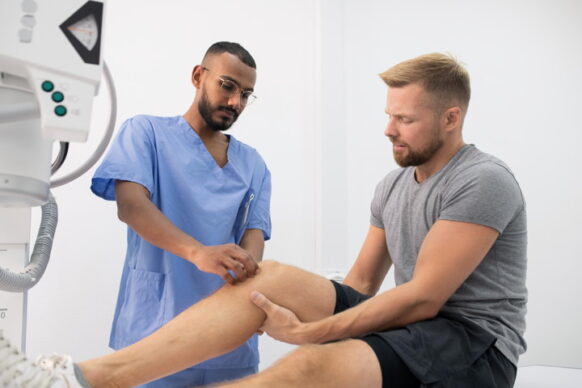Evaluating the Injured Worker – Dr. Brian Ludwig

The Occupational Safety and Health Administration (OSHA) reported more than 2.6 million non-fatal workplace injuries in 2020, which are unfortunately all too common and can cause considerable difficulties for patients. In addition to the patient factors, workplace injuries result in significant loss of time, productivity, and morale for the employer, as well.
The initial evaluation of an injured worker is extremely important to determining the appropriate treatment plan to minimize the repercussions to both the worker and the employer. Here are key considerations when initially evaluating the injured worker.
Determining What Happened During a Workplace Injury
The most important part of evaluating a patient with a work-related (or non-work related) injury is the patient’s historical account of what happened. Questions such as:
- When did the injury occur?
- What was the worker doing when the injury occurred?
- Where is the pain located? Does it radiate in any direction?
- Are there any associated symptoms (numbness/tingling/burning)?
- What are the aggravating and relieving factors for the pain?
- What treatments – both successful and unsuccessful – have been tried?
- Does the patient have a prior history of pain in the area?
- Has the patient had prior surgical procedures in/on the area?
- How long has the worker been doing the job where they were injured?
- A detailed job description is helpful for the evaluating physician as it aids in understanding the demands placed on the worker and possible ergonomic environments that could lead to causality or be changed to bring the worker back to their baseline functional status.
There are a few basic questions to start evaluating a Workers’ Compensation injury. The patient’s history is crucial because it guides the remainder of the evaluation, including a physical exam, imaging, and the treatment process and is vital when determining causality in Workers’ Compensation claims.
Physical Exams for Workplace Injuries
A comprehensive physical exam is useful when evaluating an injured worker to note findings such as strength, range of motion, provocative tests (impingement, instability), neurologic, motor, and sensation, all of which gives insight into the potential pathology. Often overlooked on examination is an inspection of the skin and muscle tone. Watching how the patient carries themselves when entering and leaving the exam room, as well as during the exam, can offer subtle signs of the presenting injury and any potential indication of malingering or symptom exaggeration. A thorough history and physical exam can often lead to a diagnosis before any imaging or testing is initiated.
Imaging for an Orthopaedic Workplace Injury
Imaging via x-ray is an easy first step and can help determine if the worker’s injury is a fracture, dislocation, underlying degenerative joint disease, or other osseous pathology. An MRI scan can be ordered based on the patient’s symptoms. MRIs are the best imaging modality for evaluating soft tissue pathologies such as tendons, ligaments, cartilage, or muscle injuries.
As patients age, it could be difficult to assess whether the MRI-discovered pathology is related to the normal aging process or the noted work injury. This is especially true for patients fifty (50) years and above when the MRI shows degenerative signs or changes.
Determining acuity of the findings is, at times, difficult with MRI imaging. Other modalities such as ultrasound and CT scans can be useful in the appropriate clinical scenario (CT for fracture delineation, as an example).
Treatment Options for Injured Workers
Treating the injured worker can take many forms depending on the pathology found during an evaluation:
- Time and activity modifications (work restrictions)
- Physical therapy
- Injection therapy
- Oral anti-inflammatories
- Slings, braces, or similar
- Surgery, if necessary
- Work restrictions allowing the patient modified duty – this can keep the patient in the work environment, rather than out of work altogether
- Narcotic pain medication should be avoided except when indicated by the injury
Treating injured workers is a complex process that entails multiple steps. A thorough history, physical examination, and review of the imaging will frequently lead to an accurate diagnosis and treatment plan. Following these steps can help determine causality of the injury if that is in question. Assisting the injured worker’s return to their career after a work injury is extremely gratifying for both the medical provider and the patient.
About Dr. Brian Ludwig
Dr. Brian Ludwig, the author of this article, is one of our fellowship-trained sports medicine specialists at OrthoGeorgia. Dr. Ludwig is a board certified orthopaedic surgeon with a special interest in sports medicine, athletic injuries, ACL reconstruction, arthroscopy of the shoulder and knee, fracture care, and total joint reconstruction (knee and shoulder). He is certified for MAKO (Stryker) and ROSA (Zimmer) robotic assisted joint replacement. Dr. Ludwig is very involved in the local sports community, covering sporting events and providing athletic screenings for high school and college athletes. He also serves as the team physician for Mercer University’s football, baseball and softball programs, as well as the head team physician for Middle Georgia State University and Fort Valley State University. Dr. Ludwig meets with patients at our Warner Robins, Kathleen, and Hawkinsville locations.
Care for Orthopaedic Workplace Injuries in Central GA
At OrthoGeorgia, we provide care for a wide variety of orthopaedic injuries, including those that occur in the workplace. We will take all steps needed to determine the severity of the injury and formulate a treatment plan with your specific situation and needs in mind. We proudly provide our orthopaedic care services, which include spine, hand, sports medicine, foot & ankle, and total joint care, to patients of all ages. For your convenience, we have offices located in Macon, Macon Spine and Orthopaedic Center, Warner Robins, Kathleen, Milledgeville, Dublin, and Hawkinsville. If you were recently injured in the workplace, while playing your favorite sport, or even just at home, contact OrthoGeorgia today to schedule an appointment for comprehensive orthopaedic care in Central Georgia.

Personalized Orthopaedic Care in Central Georgia
At OrthoGeorgia, we want to help you live a healthier and more comfortable life by giving those in Macon, Warner Robins, Kathleen, Milledgeville, Dublin, Hawkinsville, and the surrounding areas convenient access to the highest quality care. Whether you have been suffering from a sports injury or a common orthopaedic condition, we will determine the cause of your discomfort and craft a personalized treatment plan to bring you relief. To learn more about our services and our physicians, or to schedule an appointment at OrthoGeorgia, please contact us today.







